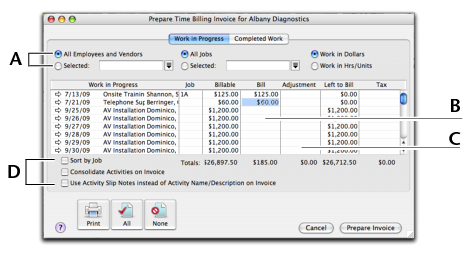Billing for time > Creating time billing invoices
|
■
|
In the Prepare Time Billing Invoice window. This is the recommended method because the full details of activities and activity slips are recorded.
|
|
■
|
In the Sales window. Use this method if you don’t need to record details of activities and activity slips or track work in progress.
|
To create a time billing invoice using the Prepare Time Billing Invoice window 

The Prepare Time Billing Invoice window allows you to enter and adjust the billing information for activity slips. As you make changes in the Prepare Time Billing Invoice window, your activity slip records are updated automatically.
|
1
|
Go to the Time Billing command center and click Prepare Time Billing Invoice. The Time Billing Customers window appears.
|
If you charge your customers for both activities and items on a single invoice, you need to select the I Include Items on Time Billing Invoices option in the Preferences window. See Setting time billing preferences.
|
2
|
Find and select the customer for whom you want to create a time billing invoice and click OK. The Prepare Time Billing Invoice window appears, listing all the open activity slips for the selected customer.
|
|
Type the amount or number of hours you want to bill for each activity slip here. Any activity slip with 0.00 units or $0.00 in the Left to Bill column is considered billed in full.
|
||||
|
Enter any adjustments you want to make for each activity slip here.
|
||||
|
||||
|
3
|
Click Prepare Invoice. The Sales - New Time Billing window appears with the details of the time billing invoice.
|
|
4
|
If you have selected the I Include Items on Time Billing Invoices option in the Preferences window, you can also enter items on this invoice. See Setting time billing preferences
|
|
■
|
the date in the Date field
|
|
■
|
|
■
|
the item number in the Activity field
|
|
■
|
the price of the item in the Rate field
|
|
■
|
[optional] the job number in the Job field.
|
|
■
|
the appropriate tax code in the Tax field.
|
|
5
|
If you want to group and subtotal the items and activities separately on the invoice, you can do so by inserting headers, blank lines and subtotals. For more information, see Adding and deleting transaction lines, subtotals, and headers in sales transactions.
|
|
6
|
Enter additional information about the sale, such as the salesperson, referral source, and invoice delivery status.
|
|
■
|
|
■
|
Print and record the invoice. Click Print and then choose the form you want to use for this invoice. For more information about printing invoices, see Sending forms. Note that the invoice is recorded before it is printed.
|
|
■
|
Save the invoice as a recurring template. Click Save as Recurring. Enter the necessary information about the template in the Edit Recurring Schedule window and click Save.
|
Note that no activity slips are created when you use the recurring sale in the future. Also, recording the recurring sale will not update the activity slips you used to create the invoice in the Prepare Time Billing Invoice window.
note : Activities billed using this procedure will not appear in most time billing reports
If you use this method to create a time billing invoice, no activity slip records will be created. Most time billing reports are based on activity slip records, therefore, if you want to print time billing reports, you should create activity slips and then use the Prepare Time Billing Invoice window to create the invoice.
|
1
|
|
2
|
In the Customer field, type or select the customer you want to invoice.
|
|
3
|
|
4
|
|
■
|
the date the activity was performed in the Date field
|
|
■
|
the number of units or hours being billed in the Hrs/Units field
|
|
■
|
|
■
|
|
■
|
|
6
|
If you have selected the I Include Items on Time Billing Invoices option in the Preferences window, you can also enter items on this invoice. See Setting time billing preferences
|
|
■
|
the date in the Date field
|
|
■
|
|
■
|
the item number in the Activity field
|
|
■
|
the price of the item in the Rate field
|
|
■
|
|
7
|
If you want to group and subtotal the items and activities separately on the invoice, you can do so by inserting headers, blank lines, and subtotals. For more information, see Adding and deleting transaction lines, subtotals, and headers in sales transactions.
|
|
8
|
Enter additional information about the sale, such as the salesperson, referral source, and invoice delivery status.
|
|
■
|
Save the invoice as a recurring template. Click Save as Recurring. Enter the necessary information about the template in the Edit Recurring Schedule window and click Save. For more information about recurring transactions, see Recurring transactions.
|
|
■
|
|
■
|
Print and record the invoice. Click Print and then choose the form you want to use for this invoice. For more information about printing invoices, see Sending forms. Note that the invoice is recorded before it is printed.
|


